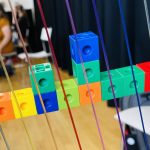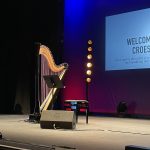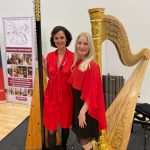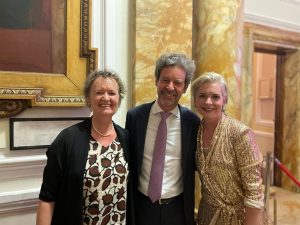Camac Blog
The World Harp Congress, Cardiff: day three!
Latest
July 25, 2022
The World Harp Congress has already featured some really interesting teaching classes. Yesterday, Morwenna Louttit-Vermmatt gave a great workshop about learners with additional needs, and today, Csilla Gulyaś introduced us to the Kodály method. Of course, the two sessions had different points of focus, but both made us reflect that there are many available keys to unlock music for students. For example, Morwenna has come up with rainbow-coloured strings for harps. Combined with various forms of colour-coded notation, these offer an alternative to reading sheet music, whose many black-and-white lines can be difficult for dyslexics. She also discussed ways for music-making to be inclusive for non-verbal or physically handicapped students.
Kodály’s method, meanwhile, is not focused on additional needs but aims to train children’s musical ears in as natural a way as possible. It begins with nursery and folk songs in the child’s mother tongue, includes improvising and experimenting, and emphasises the fact that music is for everyone. As such, music becomes part of the culture the child is already immersed in, rather than a separate task to learn by rote. Singing with different gestures and syllables to mark time was clearly particularly effective (rather than counting, which must be one of the hardest ways to teach rhythm to small children).
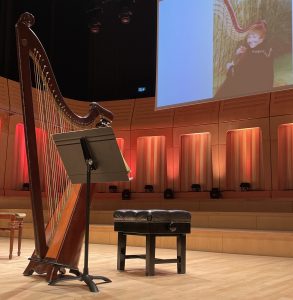 In the second half of the morning, we felt privileged to attend a moving tribute to the late Ann Griffiths, compiled by Helen Davies and presented by Val Aldrich-Smith. Ann studied with Pierre Jamet at the Paris Conservatoire and returned to Wales determined to transmit this style of teaching, founding summer masterclasses to which she invited international professors. Standard now, it was, Val reminded us, trail-blazing at the time. Ann was also one of the earliest supporters of Camac harps, and we will always be grateful for her faith in our instruments when they were very young.
In the second half of the morning, we felt privileged to attend a moving tribute to the late Ann Griffiths, compiled by Helen Davies and presented by Val Aldrich-Smith. Ann studied with Pierre Jamet at the Paris Conservatoire and returned to Wales determined to transmit this style of teaching, founding summer masterclasses to which she invited international professors. Standard now, it was, Val reminded us, trail-blazing at the time. Ann was also one of the earliest supporters of Camac harps, and we will always be grateful for her faith in our instruments when they were very young.
Milena Hoge gave an impressive workshop-demonstration on advanced pedal techniques for jazz harp: early attempts to copy them later failed, but practice makes perfect and hope springs eternal. Milena is currently a jazz student at the Hamburg Hochschule für Musik – and it was a strong afternoon for Germany at the WHC, for Milena was followed by Evelyn Huber and Margaret Köll’s fantastic duo recital of Welsh triple and Big Blue electroacoustic harp. With music ranging from Dowland to Evelyn’s own compositions and Gregor Hübner’s “Barcelona”, specially written for this combination, the sound was varied, original and blended really well (for the curious who were not there, Evelyn has a recording of Barcelona available here on YouTube).
- Milena Hoge shows us how to change nineteen pedals at once (she succeeded, we failed)
- The Camac parties have begun…many thanks to Ben Creighton-Griffiths for inaugurating the blue Jubilé with such a great jazz set.
- Evelyn Huber and Margaret Köll after their super “Baroque Harp Meets Pedal Harp” recital
The evening brought more new music, and a particularly exciting evening for us: Catrin Finch performed “Hive”, a new concerto by Sally Beamish, with the BBC National Orchestra of Wales conducted by Ariane Matiakh. Sally Beamish was also present and introduced her work to a sold-out City Hall: “Hive” is about the life cycle of bees throughout the seasons, and has been co-commissioned by the WHC and the BBC Proms. Its skilful, dramatic orchestration provided a fitting backdrop for Catrin’s virtuosity, and the combination of this, BBC NOW’s powerful sound and the electroacoustic harp rising effortlessly above it brought the house down.
Perhaps it’s only at the World Harp Congress (or a Camac festival!) that you can be treated to three harp concertos in one evening, and we also loved Anne-Marie O’Farrell’s “In Light Anew” Concerto for Lever Harp and Orchestra, commissioned by RTÉ Lyric FM, and receiving its world premier at the Congress. Finally, the Glière Concerto was exquisitely performed by Anneleen Lenaerts. What can we say? It is hard to imagine how it could have been better-played.
A standing ovation for Anneleen Lenaerts
Travelling with your own wine fridge is surely one mark of an experienced WHC attendee and one further event has nestled into the WHC programme as from today: Camac’s exhibition stand pop-up concerts. Join us every day at 17:30 for an impromptu half hour with a great artist on the Camac stage and a refreshing aperitif in your hand. Many thanks to Ben Creighton-Griffiths for getting the Camac parties started today, with a great jazz set that also marked our electroacoustic Jubilé‘s very first performance.

